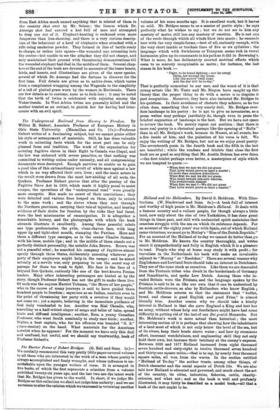Under . the African Sun : a Description of Native Races
in tjganda, Sporting Adventures, and other Experiences. By W. J. Ansorge, Medical Officer to her Majesty's Government in Uganda. With Illustrations from Photographs by the Author and 2 Coloured Plates. (William Heinemann. 21s.)—Dr. Ansorge's book is a very big and heavy one to hold, but it is light reading enough, and the pic- tures in it are perhaps the best we have seen in any work of African traveL It does not attempt to give any clear view of political events in Uganda, nor any outline of the mutiny, though the writer was in the country during the worst of it, and came near to be among the victims. The body of Soudanese with whom he was stationed at Fovira and at Masindi in Unyoro, did not, indeed, actually revolt, but they were within an inch of it, and nothing, as it would seem, held them back but the influence of their own Soudanese officers. Nor does Dr. Ansorge express any opinion as to the causes of the mutiny. One fact, however, which he records is significant. In 1895 he was in charge at Kampala during an illness which incapacitated Colonel Colville ; an attempt among the Waganda chiefs to stir up disturb- ance was only checked by prompt action. Yet Dr. Ansorge's successor on taking over control of the place decided to pull down the stockade round the fort and fill the trench. Since then a fresh rebellion has made it necessary to build a new fort in all haste ; an incisive comment on the amazing overconfidence which seems to have been at the root of so many misfortunes in that unlucky country. Dr. Ansorge has the merit of attributing to himself no heroic part. He did his best, but he frankly owns that he was not master of the situation, and, indeed, as a civilian he was in no way responsible for it. The same characteristic is marked in his sporting stories ; he records quite as many failures as successes. With lions he does not seem to have been lucky except in the matter of escapes ; but his narrative sends up one's respect for the king of beasts. One would hardly think that a single lioness could keep a camp full of armed men in terror night after night ; yet so it is. The stories of the ferocity and daring of these beasts which come
from East Africa much exceed anything that is related of them in the country shot over by Mr. Seisms ; the lioness which Dr. Ansorge shot had entered a but full of men and attempted to drag one out of it. Elephant-hunting is reckoned even more dangerous than lion-shooting, and there is a very curious descrip- lion of the behaviour of a herd of elephants when attacked with a rifle using smokeless powder. They formed in line of battle ready to charge, or rather into square—the wounded one retreating into the centre—but unable to see the attacker they did not charge, and only maintained their ground with threatening demonstrations till the wounded elephant had died in the middle of them. Several chap- ters at the end of the book are devoted to accounts of the lesser beasts, birds, and insects, and illustrations are given of the rarer species, several of which Dr. Ansorge had the fortune to discover for the first time. Full details are given as to native dress, which varies from a complicated wrapping among the Waganda to the simplicity of a tail of plaited grass worn by the women in Kavirondo. There are few details as to customs, none as to folk-lore ; it may be noted that the birth of twins is celebrated with rejoicing among the Wakavironda. In West Africa twins are generally killed and the mother treated as an outcast, to punish her for having had inter- course with an evil spirit.



















































 Previous page
Previous page